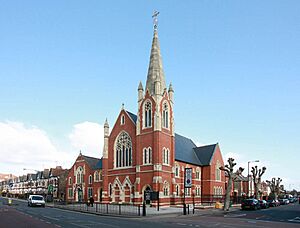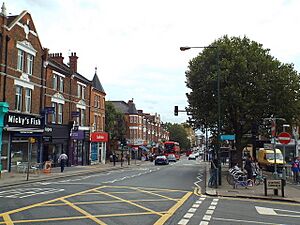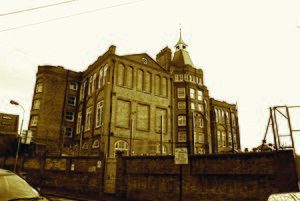Kensal Green facts for kids
Quick facts for kids Kensal Green |
|
|---|---|
 Church of the Transfiguration, Chamberlayne Road |
|
| Population | 14,915 (2011) (Kensal Green ward) |
| OS grid reference | TQ235825 |
| Ceremonial county | Greater London |
| Region | |
| Country | England |
| Sovereign state | United Kingdom |
| Post town | LONDON |
| Postcode district | NW10 |
| Postcode district | W10, NW6 |
| Dialling code | 020 |
| Police | Metropolitan |
| Fire | London |
| Ambulance | London |
| EU Parliament | London |
| UK Parliament |
|
Kensal Green is a lively area in north-west London. It's part of North Kensington. You'll find it north of the canal in the London Borough of Brent. It also stretches south into Kensington and Chelsea. Kensal Green is located on the Harrow Road. It's about 4.4 miles (7.1 km) from Charing Cross, a famous spot in central London.
To the west of Kensal Green on Harrow Road is Harlesden. In the other direction are Maida Hill and Westbourne. Queens Park and Brondesbury are to the north-east. Willesden is to the north-west, and Notting Hill is to the south.
Kensal Green is most famous for the historic Kensal Green Cemetery. This cemetery is so important it's listed as a Grade I building.
Contents
What's Kensal Green Like?
Shops, Restaurants, and Fun Places
Kensal Green has become a very popular and trendy place. Many people from nearby areas like Notting Hill and Queen's Park have moved here. The area is full of cool independent shops, restaurants, pubs, and cafes. It's known as a place where celebrities like to hang out.
In 2009, Vogue magazine even called Chamberlayne Road the "hippest street in Europe." A luxury brand called Mulberry named one of its handbags "Kensal." They even had a big ad campaign with model Cara Delevingne.
You can also find many sports clubs, gyms, and health studios here. There's the Moberly Sports Centre and Gracelands Yard. Queens Park is also nearby. Kensal Green is home to Britain's first independent cinema that's also a social enterprise. It's called The Lexi Cinema. Local volunteers work there, and all the money it makes goes to help an eco-village in South Africa.
Famous People Who Live Here
Many famous people have lived in Kensal Green. These include musicians Paloma Faith and Rita Ora. Chef Thomasina Miers and film director Don Letts have also called it home. Other famous residents include actress Thandiwe Newton and singer Lily Allen. Author Zadie Smith and actress Phoebe Waller-Bridge have lived here too.
Kensal Green has always been popular with people who work in media and creative jobs. Now, more people from finance and technology are moving in. They often come from Notting Hill looking for bigger homes. The area is also popular with Americans because of The American School in London nearby. Many French families like it too, especially since a Lycée Français opened in Brent's old town hall.
Community Spirit
The people of Kensal Green are very active in their community. In 2014, residents successfully fought to save their local library. It had been sold to a developer, but they managed to keep it open.
More recently, The Lexi Cinema raised £141,000 from locals and businesses. This money helped create a community hub. The local council and the Mayor of London also supported this project.
In 2021, residents of Clifford Gardens stopped the council from paving over their green pavements. They started a petition and got 544 signatures in just one week. When workers arrived, a large crowd of parents and children blocked the street. This showed how much the community cares about its green spaces.
Parks and Green Spaces
Kensal Green has some great places to enjoy the outdoors.
- Emslie Horniman's Pleasance Park: This park on Bosworth Road has tennis courts and football pitches. It also has a playground for children.
- Queens Park: This larger park offers tennis courts and even golf. It has a petting zoo and a big children's playground.
- King Edwards Vll Park: This park is also within walking distance.
Brent Council announced plans in 2019 to make the public areas even better. These changes include new cycle lanes and ways to reduce traffic. There will also be new pavements, resurfaced roads, and community greening projects. These include small "pocket gardens" to make the area look nicer.
Getting Around Kensal Green
Train and Tube Services
Kensal Green station is on the Bakerloo line of the London Underground. It's in Travelcard Zone 2. From here, you can reach Oxford Circus and the West End in about 20 minutes. London Overground trains also run from Kensal Green station. You can get to London Euston in about 15 minutes. Trains also go to Watford Junction.
Kensal Rise railway station is also in Travelcard Zone 2. It's on the London Overground's North London Line. This line offers regular services to Richmond in the west. You can also go to Stratford in the east and Clapham Junction in the south.
Bus Services
Kensal Green has many bus routes.
- Route 18 goes from Sudbury to Euston.
- Route 6 goes from Willesden Bus Garage to Aldwych.
- Route 52 travels from Willesden Bus Garage to Victoria station. It passes through Notting Hill and Kensington.
- Route 452 connects Kensal Rise to Vauxhall.
Canal and Future Transport
Kensal Green is located on the Paddington Arm of the Grand Union Canal. This canal passes right by Kensal Green Cemetery. You can walk or cycle along the canal to places like Little Venice and the Paddington Basin. It also connects to Paddington Station and Regents Canal.
In 2020, the government approved the High Speed 2 (HS2) train link. This new high-speed railway will connect London to Birmingham. A major HS2 and Crossrail station will be built at Old Oak Common. This station will be within walking distance of Kensal Green. It's expected to open in 2026. This will provide fast train travel across London and to the Midlands. It will also connect directly to the Heathrow Express airport link. Trains to Wales and the West of England will also be available. This will be the largest new railway station ever built in the UK!
Schools in Kensal Green
Kensal Green has several good schools. The Ark charity runs three state primary schools in the area. One of these is Ark Franklin in Harvist Road. It replaced Kensal Rise primary in 2013. Local residents think very highly of it. In 2024, Ark Franklin was congratulated by the Minister of Education. It was in the top 2% of schools for early years performance.
As of 2020, these state primary schools are rated "good":
- Ark Franklin
- Princess Frederica CofE in College Road
- Kenmont Primary School in Valliere Road. This school was built in 1883–84 and is a Grade II listed building.
Three state secondary schools are also rated "good." These include Queens Park Community School and Capital City Academy.
For private education, there are a few local choices. Seacole and The Lloyd Williamson School are primary schools. Bales College is a small independent secondary school and sixth form college. Many parents also use private schools in nearby Belsize Park and Hampstead.
Kensal Green Cemetery
Kensal Green Cemetery is one of London's first large cemeteries. It's known as one of the 'Magnificent Seven' cemeteries. Many important people are buried here. This includes members of the royal family like Prince George, Duke of Cambridge. Famous historical figures like Isambard Kingdom Brunel and Charles Babbage are also buried here.
Many artists and writers are laid to rest here too. These include playwright Harold Pinter and authors William Makepeace Thackery and Anthony Trollope. The family plot of engineers Marc Brunel and Isambard Kingdom Brunel is also in the cemetery.
Some famous people were cremated at the West London Crematorium, which is inside the cemetery grounds. These include Queen frontman Freddie Mercury, actor Alan Rickman, and actress Ingrid Bergman.
The cemetery directors and a charity called The Friends of Kensal Green Cemetery work to preserve this historic site. They have received funding to help repair historical monuments. A big project in 2015 repaired the Anglican Chapel and the boundary wall. This project cost over £10 million.
The cemetery is listed as a Grade I site on the Register of Historic Parks and Gardens. Many of its buildings and memorials are also listed buildings.
Kensal Green's History
Kensal Green was first mentioned in 1253. Its name comes from old English and means 'the King's Wood'. It marked the boundary between Willesden and Chelsea & Paddington. For a long time, Kensal Green was mostly farmland. This was because All Souls' College, Oxford owned much of the land.
In 1805, the Grand Junction Canal was built through the area. This canal connected to the Regent's Canal at Paddington. This allowed boats to carry goods from the Midlands to London Docks and the River Thames.
Dairy farms grew in Kensal Green after 1864. This was when it became illegal to keep cattle in the City of London. Even in the 1890s, many sheep and pigs were raised here. One farm later became a United Dairies creamery, receiving milk by train.
St. John's Church was built in 1844. It's on the corner of Harrow Road and Kilburn Lane. The church was renovated in 2017. In 1832, Kensal Green Cemetery was officially opened. This led to more development in the area.
By the 1860s, the Kensal Green manor house was taken down. More homes were built, especially west of Kilburn High Road. However, Kensal Green faced big social problems at this time. Many residents lived in poverty. In 1880, it was reported that drainage and sewage systems were not good enough.
Later, All Souls' College started developing its lands. They built new roads like All Souls' Avenue and College Road. They also installed new sewage systems. The college donated land for the Kensal Rise Reading Room. This was built to celebrate Queen Victoria's Diamond Jubilee in 1897. American author Mark Twain opened it in 1901. It later became Kensal Rise Library.
The streets around Kensal Rise railway station were developed in the late 1800s and early 1900s. The station opened in 1873 as Kensal Green. It was renamed Kensal Rise in 1890. A sports ground, the National Athletic Ground, opened nearby in 1890. It hosted cycling and athletics before becoming housing in the 1920s. Kensal Green also had the Electric Pavilion Cinema, which opened in 1914.
The Great Western Railway started construction in 1835. In 1901, a large train maintenance facility was built at Old Oak Common. This brought more jobs and people to the area. The first major group of immigrants were Irish people fleeing the Great Irish Famine. After World War I, more immigrants arrived. During World War II, Kensal Green was heavily bombed because of its railway facilities.
After the war, many Afro-Caribbean people moved to Kensal Green. In the 1960s, All Souls' College sold many of its land ownerships. The Irish community has become smaller since the 1980s. However, their history is still seen in the Irish pubs and organizations. Many thousands of people with Irish ancestry still live in the area.
Kensal Green Demographics
According to the 2011 census, the largest ethnic group in the Kensal Green area was White British. The second largest group was White other. The area also has a notable Black Caribbean population. Kensal Green has the highest Latin American population in London. The area has many young residents and a high level of education.
2006 Tornado
On December 7, 2006, a tornado hit Kensal Green at 11:00 am. It damaged up to 150 houses. Six people were injured, and one needed hospital care. Roads were closed, and some residents had to find temporary places to stay. The damage cost at least £2 million.






